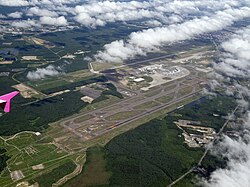
Back نيو كيتوس ايرپورت ARZ Nou Aeroport de Chitose Catalan New Chitose Airport CEB Flughafen Neu-Chitose German Nuevo Aeropuerto de Chitose Spanish Chitose rahvusvaheline lennujaam Estonian فرودگاه نیو چیتوز Persian Chitosen lentoasema Finnish Aéroport de Shin-Chitose French Sincsitosze nemzetközi repülőtér Hungarian
New Chitose Airport 新千歳空港 Shin-Chitose Kūkō | |||||||||||||||||||||||
|---|---|---|---|---|---|---|---|---|---|---|---|---|---|---|---|---|---|---|---|---|---|---|---|
 New Chitose Airport | |||||||||||||||||||||||
| Summary | |||||||||||||||||||||||
| Airport type | Public | ||||||||||||||||||||||
| Owner | Ministry of Land, Infrastructure, Transport and Tourism | ||||||||||||||||||||||
| Operator | Hokkaido Airports | ||||||||||||||||||||||
| Serves | Sapporo metropolitan area | ||||||||||||||||||||||
| Location | Chitose and Tomakomai | ||||||||||||||||||||||
| Opened | July 20, 1988 | ||||||||||||||||||||||
| Focus city for | |||||||||||||||||||||||
| Operating base for | |||||||||||||||||||||||
| Elevation AMSL | 70 ft / 21 m | ||||||||||||||||||||||
| Coordinates | 42°46′31″N 141°41′33″E / 42.77528°N 141.69250°E | ||||||||||||||||||||||
| Website | www | ||||||||||||||||||||||
| Map | |||||||||||||||||||||||
Location in Hokkaido | |||||||||||||||||||||||
 | |||||||||||||||||||||||
| Runways | |||||||||||||||||||||||
| |||||||||||||||||||||||
| Statistics (2017 = One of Mostly domestic terminal airport in Japan) | |||||||||||||||||||||||
| |||||||||||||||||||||||
Source: Japanese Ministry of Land, Infrastructure, Transport and Tourism[2] | |||||||||||||||||||||||
New Chitose Airport (新千歳空港, Shin-Chitose Kūkō) (IATA: CTS, ICAO: RJCC) is an international airport located 2.7 nautical miles (5.0 km; 3.1 mi) south-southeast of Chitose[3] and Tomakomai, Hokkaidō, Japan, serving the Sapporo metropolitan area. By both traffic and land area, it is the largest airport in Hokkaidō.
It is adjacent to Chitose Air Base, a Japan Air Self-Defense Force base which houses F-15 Eagle fighter jets, the Japanese Air Force One government aircraft and a number of smaller emergency response aircraft and helicopters. Chitose and New Chitose have separate runways but are interconnected by taxiways, and aircraft at either facility can enter the other by ground if permitted; the runways at Chitose are occasionally used to relieve runway closures at New Chitose due to winter weather.
New Chitose Airport is one of six 24-hour airports in Japan, but it is the only inland airport.
As of 2018, it was the fifth-busiest airport in Japan, serving 23.7 million passengers, and ranked 64th in the world in terms of passengers carried.[4] The 819 km (509 mi) Sapporo–Tokyo Haneda route is the second busiest air route in the world, with 9.7 million passengers carried in 2018.[5]
The airport continues to upgrade its facilities to accommodate the growing number of passengers, and Skytrax has it ranked 49th in the top 100 airports in the world in 2024, jump up from 102nd the previous year. As a result, the airport was awarded Skytrax's World's Most Improved Airport for 2024.[citation needed]
- ^ a b 18R/36L and 18L/36R are part of Chitose Air Base and operated by the Japan Air Self-Defense Force
- ^ "New Chitose International Airport" (PDF). Japanese Ministry of Land, Infrastructure, Transport and Tourism. Archived from the original (PDF) on 21 October 2016. Retrieved 7 January 2017.
- ^ "AIS Japan". Aisjapan.mlit.go.jp. Archived from the original on 2016-05-17. Retrieved 2014-05-19.
- ^ "Total Number of Domestic/International Passengers since the Opening of New Chitose Airport-Other Data | New Chitose Airport Terminal". Hokkaido-kukou.jp. 1988-07-20. Archived from the original on 2013-12-29. Retrieved 2014-05-19.
- ^ 特定本邦航空運送事業者に係る情報 (PDF). Mlit.go.jp. Retrieved 13 August 2018.

